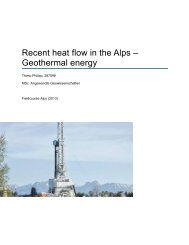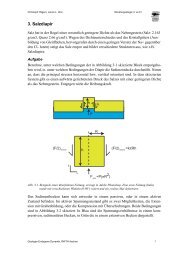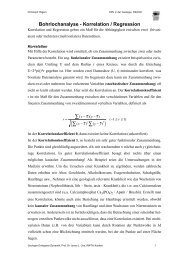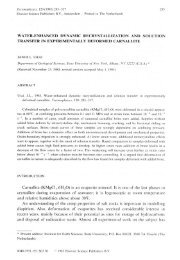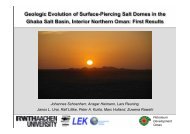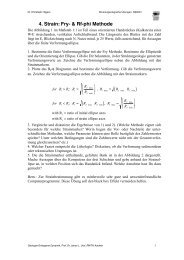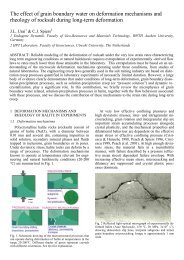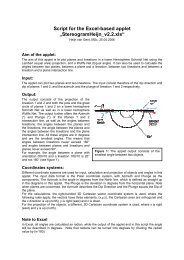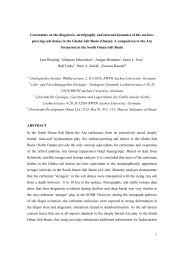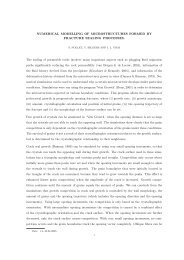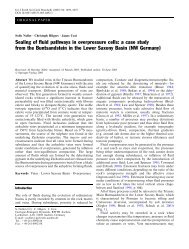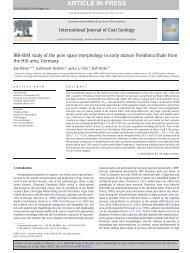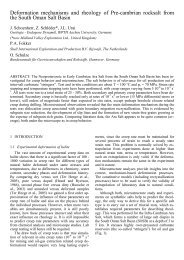Paper - RWTH Aachen University
Paper - RWTH Aachen University
Paper - RWTH Aachen University
You also want an ePaper? Increase the reach of your titles
YUMPU automatically turns print PDFs into web optimized ePapers that Google loves.
Jean-Michel Larroque Shell EP Int., P.O. Box 11677,<br />
Dubai Convention Tower, Dubai, United Arab Emirates;<br />
JeanMichel.Larroque@shell.com<br />
Jean-Michel Larroque has a Ph.D. in structural geology<br />
from Montpellier <strong>University</strong> (France) and joined the Shell<br />
structural geology team in 1988. He had assignments in<br />
the United Kingdom, Germany, and Oman as South Oman<br />
Exploration team leader. Previously, he was Shell Exploration<br />
chief geoscientist for the Middle East and the Caspian. He<br />
is now exploration manager for Shell Syria.<br />
Mark J. Newall Shell Egypt NV, P.O. Box 2681,<br />
El Horreya, Heliopolis, Cairo, Egypt; Mark.Newall@shell.com<br />
Mark J. Newall is a senior exploration geologist in Frontier Exploration<br />
in Shell, Egypt. He has a Ph.D. from Liverpool <strong>University</strong><br />
(1990) and, since joining Shell, has worked as an explorationist<br />
in Holland, Malaysia, and Oman, before moving to Cairo<br />
in 2005. He is currently exploring for gas in the Nile delta.<br />
Nadia Al-Abry Petroleum Development Oman LLC,<br />
P.O. Box 81, P.C. 113, Muscat, Oman; Nadia.SN.Abry@pdo.co.om<br />
Nadia Al-Abry holds a Ph.D. (2002) from the <strong>University</strong> of<br />
Edinburgh. Nadia joined Petroleum Development Oman<br />
in October 2002 and since then has been working on the<br />
Precambrian intrasalt Ara carbonate stringers first as an<br />
exploration team geologist and seismic interpreter and then<br />
as a production geologist. Her research interests are in the<br />
tectonic evolution of basins and its influence on sedimentation<br />
and reservoir architecture.<br />
Hisham A. Al-Siyabi Shell Exploration and Production<br />
Company, Pennzoil Place, 700 Milam Street, Houston,<br />
Texas 77002; H.Siyabi@shell.com<br />
Hisham A. Al-Siyabi holds an M.S. degree (1994) and a<br />
Ph.D. (1998) from the Colorado School of Mines. Hisham<br />
joined Petroleum Development Oman in 1999 and, since<br />
2001, has worked as a geologist and seismic interpreter<br />
exclusively on the terminal Proterozoic intrasalt Ara stringers.<br />
In 2005, Hisham joined Shell Exploration and Production<br />
Company in the United States as an exploration geologist.<br />
Zuwena Rawahi Petroleum Development Oman LLC,<br />
P.O. Box 81, P.C. 113, Muscat, Oman; Zuwena.Rawahi@pdo.co.om<br />
Zuwena Rawahi is a senior carbonate geologist in Petroleum<br />
Development Oman and has been working on the<br />
Precambrian stringer play on the South Oman exploration<br />
team for the last 3 years. Prior to that, she worked for<br />
7 years on the Shuaiba Formation. Her main interest is<br />
related to carbonate sedimentology and diagenesis.<br />
ACKNOWLEDGEMENTS<br />
We are grateful to Petroleum Development Oman LLC<br />
(PDO) and to the Ministry of Oil and Gas, Oman, for granting<br />
permission to publish this study. We thank PDO for providing<br />
the samples and for the supporting data. Uwe Wollenberg<br />
is acknowledged for conducting scanning electron<br />
microscopy, Manfred Thomé from the Research Centre Jülich,<br />
Germany, for gamma irradiation of the rock salt samples,<br />
and Werner Kraus and Rolf Mildenberger for thin-section<br />
preparation. The manuscript benefited from thorough reviews<br />
and comments of Martin P.A. Jackson, Joachim E. Amthor,<br />
David E. Eby, and Ronald A. Nelson.<br />
1542 Geologic Notes<br />
INTRODUCTION<br />
An essential element of a petroleum system in sedimentary basins<br />
is the presence of a seal. In the South Oman salt basin (SOSB),<br />
carbonate reservoirs (stringers) are fully enclosed in diapirs of the<br />
infra-Cambrian Ara Salt. This rock salt forms the top, side, and bottom<br />
seal for major hydrocarbon accumulations. In core samples directly<br />
above and below some stringers, the rock salt is stained black<br />
by solid hydrocarbons (Mattes and Conway Morris, 1990), which<br />
suggests that oil once flowed from the reservoirs into the rock salt.<br />
Rock salt is known as the best seal for hydrocarbon accumulations<br />
based on three key properties. First, the near-isotropic stress<br />
state provides resistance to hydrofracturing. Thus, under most conditions,<br />
rock salt will hydrofracture under a higher fluid pressure<br />
than shale does (Hildenbrand and Urai, 2003) because the minimum<br />
principal stress (s3) is higher. Second, in-situ permeability<br />
and porosity of rock salt are already very low at a burial depth of<br />
merely 70 m (229 ft) (Casas and Lowenstein, 1989). Third, plastic<br />
deformation of rock salt in nature is ductile and, therefore, nondilatant<br />
(e.g., Ingram and Urai, 1999; Popp et al., 2001). This is<br />
reflected by Downey’s (1984) widely accepted ranking of seals:<br />
salt ! anhydrite ! kerogen-rich shale ! clay shale ! silty shales !<br />
carbonate mudstone ! chert. However, under suitable conditions,<br />
all rocks can lose their sealing capacity. For engineering (shortterm)<br />
applications, the criteria for leakage through rock salt have<br />
been defined experimentally (Urai, 1983; Fokker et al., 1995; Popp<br />
et al., 2001; Lux, 2005). However, the geological conditions for seal<br />
loss of rock salt are not well understood.<br />
Although the black rock salt samples from the SOSB have been<br />
noticed for at least 15 yr, a detailed analysis of this staining has not<br />
been done; as far as we are aware, this is the first field study of a leaky<br />
rock salt top seal.<br />
The scope of this article is to decipher the microstructural<br />
evolution of the hydrocarbon-impregnated rock salt to quantify the<br />
mechanisms by which rock salt in the deep subsurface is able to leak<br />
and reseal and to generalize these results to rock salt seals in petroleum<br />
systems.<br />
MECHANICAL AND TRANSPORT PROPERTIES<br />
OF ROCK SALT<br />
Experimental determination of the mechanical properties of rock<br />
salt and extrapolation of these data to conditions of slow geological<br />
deformation have provided a solid basis for understanding rock salt<br />
rheology (e.g., Urai et al., 1986; Wawersik and Zeuch, 1986; Spiers<br />
et al., 1990; Carter et al., 1993; Peach et al., 2001). On the basis<br />
of these experiments, it is possible to differentiate the deformation<br />
mechanisms in rock salt based on their characteristic microstructure<br />
(Urai et al., 1987; Peach and Spiers, 1996; Schléder and Urai,<br />
2005; Ter Heege et al., 2005).



